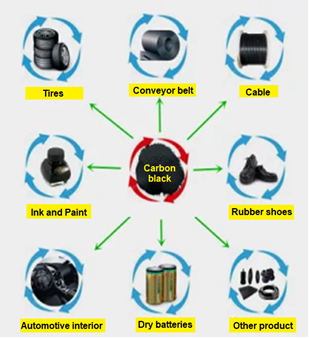As of today, only a few people know about carbon black. Their knowledge and understanding are also limited to the fact that carbon is charcoal from coconut shells or black activated carbon. In addition, some people only know carbon as carbon copy and ink material. On the other hand, there is another type of carbon that comes from oil content and can be used for various industrial purposes. This carbon is produced and used with advanced and modern technology, which is called carbon black. Currently, by looking at the market signal, carbon black has become a very profitable commodity. Carbon black industries develop systems and technologies to produce the best quality with minimized environmental effects. In fact, because of the promising price and high market demand, carbon black factories invest in advanced production equipment. In its development, through continuous research and by utilizing advances in industrial technology, currently, carbon black can be added to various materials to improve the physical, electrical, or optical properties of the material.
1. What Is Carbon Black?
Carbon black has been used extensively to modify the mechanical, electrical, and other physical properties of the medium in which it is dispersed. These are the most widely used nanomaterials, with particle dimensions ranging from tens to several hundreds of nanometers (nms). It plays a major role in elastomers, plastics, paints and inks as a reinforcing agent, black pigment and electrically conductive material [1]. Carbon black is a black particles in the form of fine powder or granules containing more than 95% pure carbon which is produced in a highly controlled process to produce particles and aggregates of various structures and surface chemistries resulting in a range of products that offer a wide range of characteristics and advantages for their uses. Carbon black is produced from decant oil which is burned at high temperatures along with other auxiliary materials consisting of molasses and additives. Apart from decant oil, carbon black can also be produced from incomplete combustion of coal and coal tar, vegetable matter, liquid catalytic cracking tar, and ethylene cracking in a limited supply of air.
Compositionally, carbon black are composed of a single compound with the chemical name of carbon black or furnace black which has the chemical formula C with CAS number RN: 1333-86-4, EINECS/ELINCS Number: 215-609-9 and weight: >99%, with a degree of acidity at pH: 4 – 11 [50 g/l water, 68ᵒF (20ᵒC)] in the non-oxidized state, and pH: 2-4 in the oxidized state. Carbon black has a density between 1.7 – 1.9 g/cm³ @ 20ᵒC, with a bulk density of 65-520 kg/m3 (granular), and 20-380 kg/m3 (downy), and has a volatile (by weight) < 2.5% (950ᵒC) in the non-oxidized state and 2-8% in the oxidized state [2].
Carbon black particles tend to join one particle with another to form aggregates that determine the class structure [3]. In general, various types of carbon black are made by the pyrolysis method of hydrocarbons, so both chemically and physically carbon black is different from graphite and diamond. Carbon black has a particle size of between 10 and 500 nm and a surface area of between 6 and 1200 m2/gm. Carbon black is odorless and is most widely used as a filler in the rubber, plastic, ink, and coating industries. Depending on the production process, carbon black has differences in particle size, surface area, porosity, and other characteristics, which determine its grade. Using these parameters, very tight control is carried out in the production process, from the front end to the back end. Carbon black in granular form is presented in Figure 1.

Figure 1. Carbon black [2]
2. Utilization of Carbon Black
Carbon black is used in small-scale industries up to large-scale industries that affect national interests. In addition to rubber reinforcement, Carbon Black is used as a black pigment and as an additive to improve material performance, including conductivity, viscosity, static charge control and UV protection. This type of Carbon Black (commonly called Special Carbon Black) is used in a variety of applications in the coatings, polymer and printing industries, as well as in a variety of other specialty applications [4]. In general, the use of carbon black is presented in Figure 2.

Figure 2. Utilization of carbon black (source: link)
2.1. Dyes for Inks and Paints
Carbon black is used as an excellent black coloring agent. Therefore, it is widely used for printing inks, resin dyes, paints and toners because it has better color strength compared to iron oxide or organic pigments. Carbon black with a larger structure shows excellent conductive properties.
2.2. Dyes for Plastics
Carbon black is suitable for coloring resins and plastic films because it has high color strength and is stable even at high temperatures.
2.3. Material for Car Bumpers, Cable Coatings, and Pipes
Due to its excellent nature of absorbing ultraviolet (UV) rays and providing better weather resistance, Carbon black is also used in the car bumper industry, wire coatings and pipe coatings.
2.4. Anti-static Agent
Carbon black is also used as an excellent antistatic agent, where the particles have a crystal structure that functions as a conductive filler in plastics, elastomers, paints, adhesives, and films. A certain type of carbon black, called special black or performance black, is used as a pigment to increase conductivity and control static charge, thereby providing UV protection and improving mechanical properties in products such as plastics, inks, paints and coatings, toners and electronics.
2.5. Mixture of Rubber Products
The use of carbon black in the largest volume is for performance additive in rubber products, especially in tires and other rubber industrial goods such as hoses, belts, extrusion profiles, and molded rubber goods. Now, the use of carbon black has also penetrated into automotive rubber parts such as hoses, belts, gaskets, seals, wipers, and all rubber parts.
References
[1] M. Wang, C. A. Gray, S. A. Reznek, K. Mahmud, and Y. Kutsovsky, “Carbon black,” Kirk‐Othmer Encyclopedia of Chemical Technology, 2000.
[2] Eurotecnica, “Carbon black,” Feb. 26, 2023. https://www.eurotecnica.it/en/technologies/carbon-black.html (accessed Feb. 26, 2023).
[3] E. B. Sebok and R. L. Taylor, “Carbon blacks,” Encyclopedia of Materials: Science and Technology, pp. 902–906, 2001.
[4] S. Usmani, “Everything you need to know about carbon Black.” Feb. 26, 2022, [Online]. Available: https://www.bioenergyconsult.com/carbon-black/.
Original Source: Carbon black: Production, properties, and utilization












